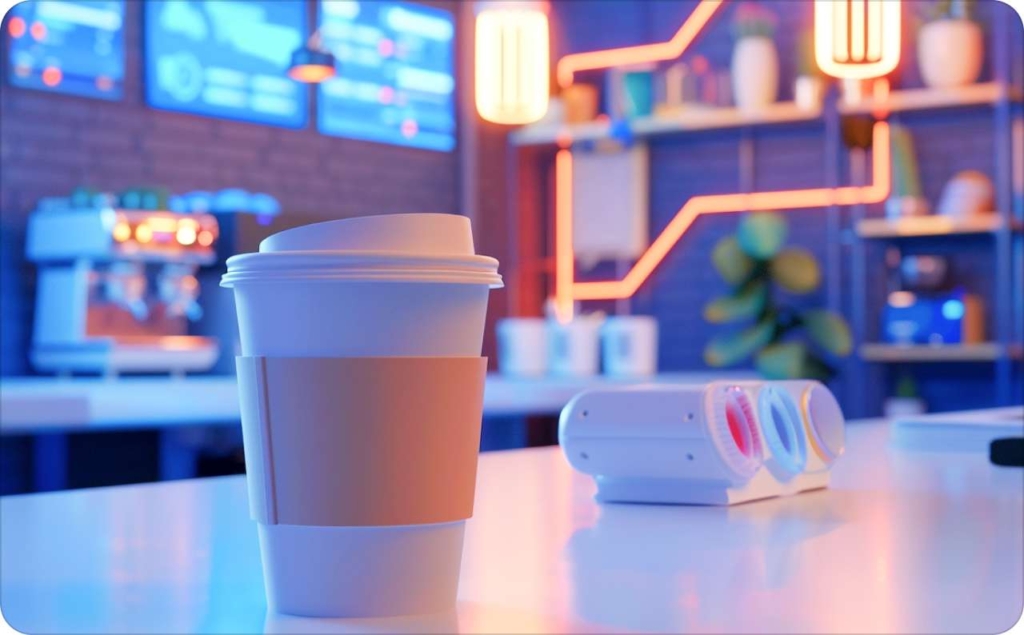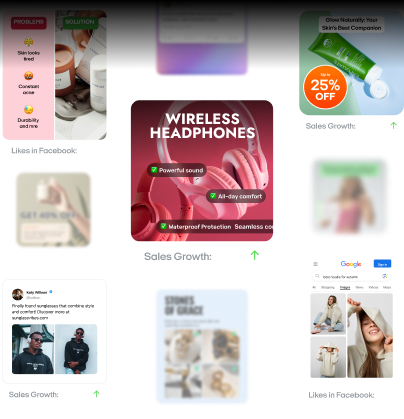Targeted display advertising: 20 real brand examples that prove precision drives growth
Targeted display advertising uses contextual, first-party, proximity, geo, and modeled data signals to deliver the right message at the right moment across web and in-app placements. Modern display ad targeting now relies less on third-party cookies and more on consented, privacy-safe data. For mid-market teams, this precision drives efficiency and measurable growth, as shown by Think with Google.
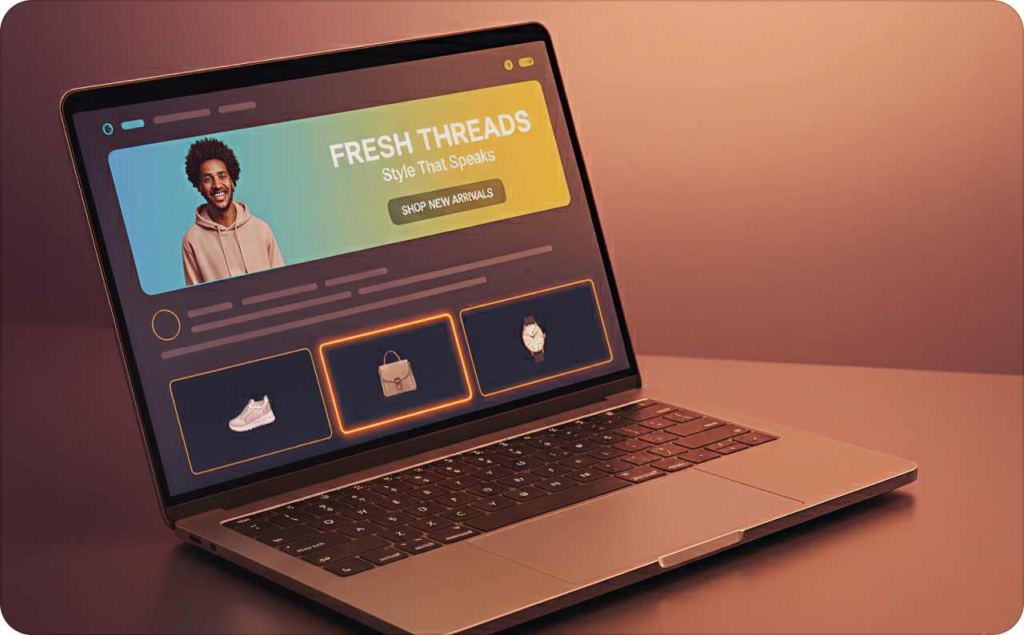
Targeted display examples
Each example shows how smart targeted display advertising turns precise data into real performance. From contextual relevance to geo-based reach and modeled lookalikes, these campaigns prove that when display targeting meets clear creative, even modest budgets can scale efficiently, especially relevant now that global ad revenue is forecast to grow only 6% in 2025, according to Reuters.
Geo and proximity targeting
When display ads targeting location and movement data meet relevant creative, they turn digital attention into real-world action. This group of examples shows how thanks to targeted display advertising strategies, small businesses can move people from screen to store, proving that well-timed, location-aware campaigns still deliver some of the most measurable results in digital media. From garden centres and museums to dealerships and coffee shops, each brand here connects online impressions to verified visits, showing that local relevance drives real performance.
1. Dobbies Garden Centres local footfall ad
This tactic uses display ads targeting local audiences to drive measurable store visits. Dobbies combined geo-based audience data with footfall attribution to connect online impressions directly to in-store outcomes. The creative highlighted nearby offers and seasonal relevance, proving how location-aware display can convert attention into action.
Why it works
- Links online engagement with verified offline visits
- Keeps creative relevant to place and timing
- Demonstrates real-world ROI with clear attribution
- Optimizes spend by tracking cost per visit and visit rate
How to use it in your advertising: Imagine a customer browsing a gardening blog near one of your stores. They see an ad: “Your spring blooms are just down the road.” Use targeted display advertising with location data and footfall tracking to connect impressions to real visits. Keep copy grounded, timely, and conversational, helpful, not salesy.
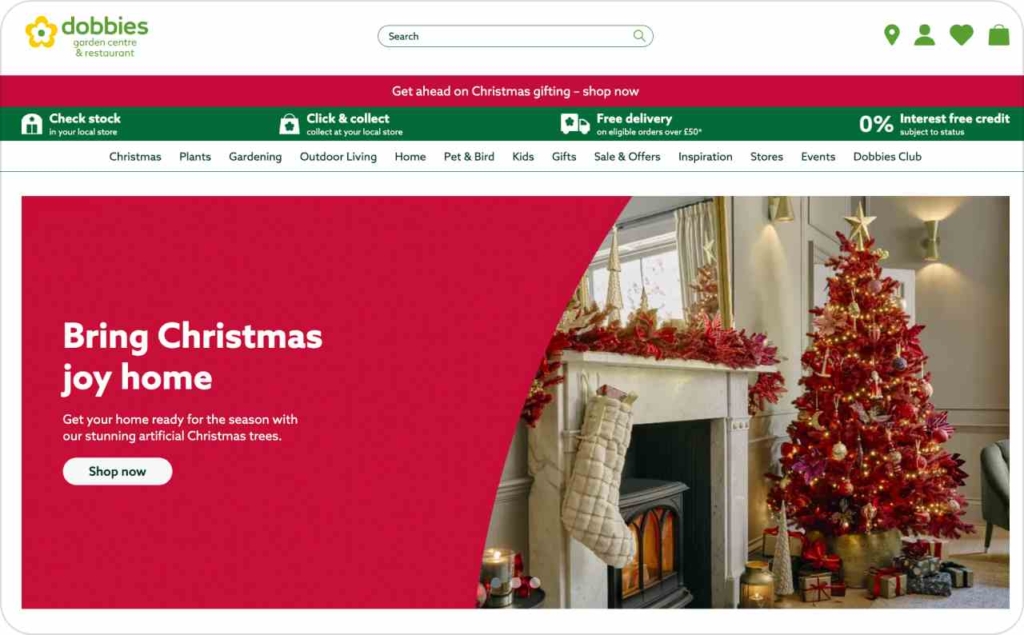
Photo source: Dobbies Garden Centres
2. The Mint Museum local proximity ad
Using display ads targeting visitors within a defined radius around its venues, The Mint Museum turned location cues into real attendance. Focused on mobile placements, the campaign reached people nearby with creative tied to current exhibits and community events, transforming simple geo data into cultural engagement that felt personal and timely.
Why it works
- Uses proximity to activate interest when intent is highest
- Keeps messaging hyper-local and relevant to context
- Reduces wasted impressions through precise geo boundaries
- Measures performance clearly through cost per visit and verified attendance
How to use it in your advertising: Picture someone walking near your venue, scrolling through their phone. They see an ad: “Discover what’s happening just around the corner.” Use targeted display advertising within proximity zones to drive in-person visits. Keep visuals tied to place, and frame copy as an invitation, not a pitch.
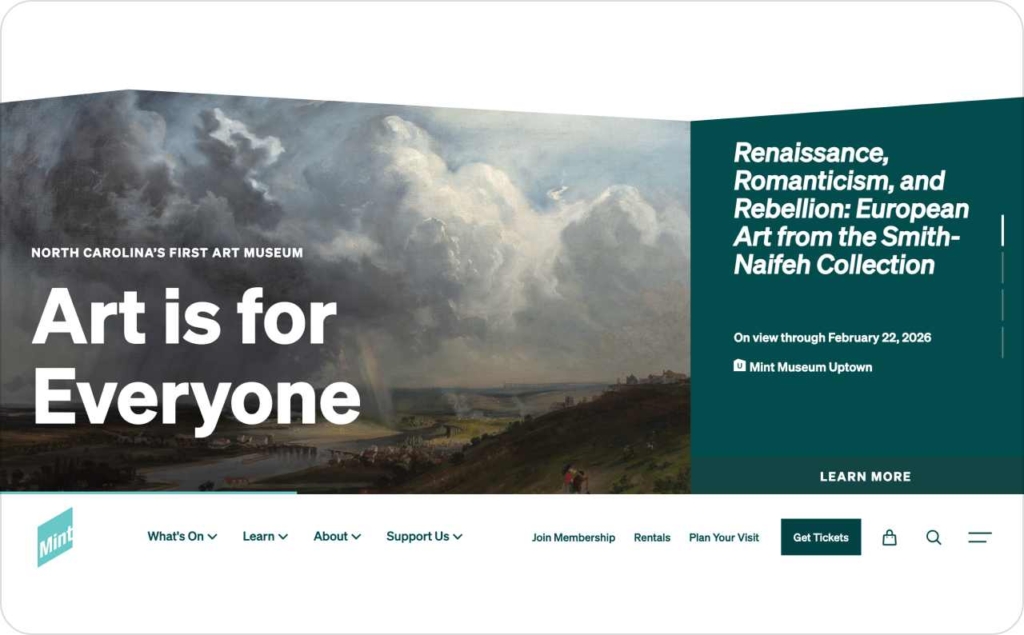
Photo source: The Mint Museum
3. Martin County Tourism destination awareness ad
This tactic uses display ads targeting travelers within and around Florida to promote outdoor experiences through targeted display advertising on mobile and connected TV. By mapping destination geos to outdoor-interest cohorts, the campaign delivered measurable tourism lift, tracking actual visits and cost per visit with verified data partners.
Why it works
- Aligns destination intent with audience interest in real time
- Combines mobile and CTV reach for multi-screen consistency
- Tracks true tourism impact with cost-per-actual-visit attribution
- Builds awareness that converts to physical exploration
How to use it in your advertising: Picture a traveler planning a weekend trip near your region. They see a video ad: “Find your next hidden trail just a short drive away.” Use targeted display advertising with destination-based geo segments to reach intent-driven audiences. Keep visuals immersive, highlight proximity, and measure success through verified visit data.
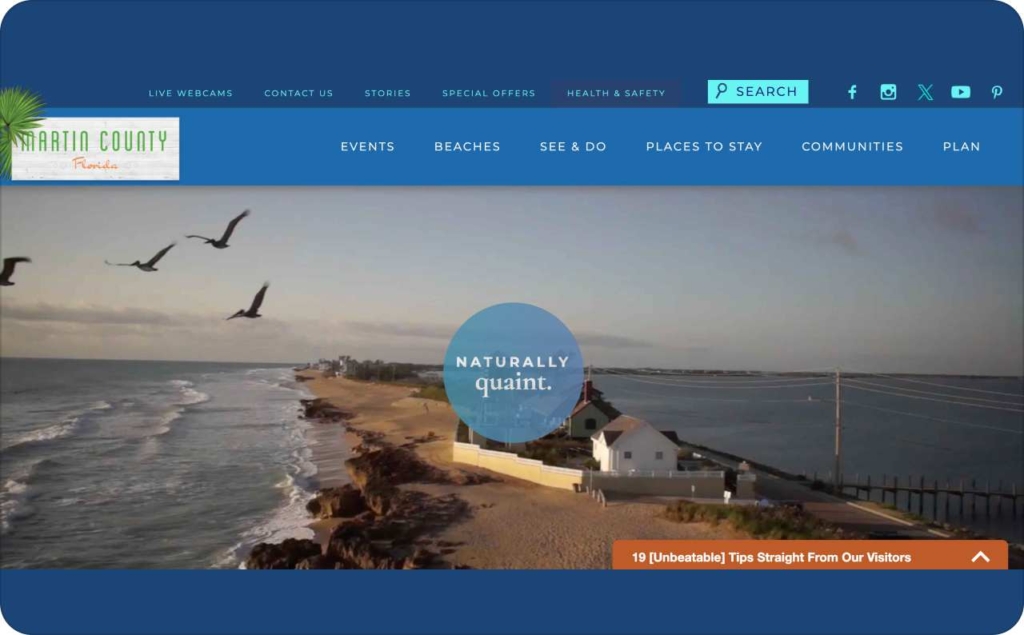
4. Sharp Auto dealership proximity ad
By using display ads targeting shoppers near the dealership lot, Sharp Auto turned mobile location and audience data into real-world visits. The team combined POI (point of interest) signals with proximity mapping to reach potential buyers in real time, converting ad impressions into verified on-lot traffic at an efficient cost per visit.
Why it works
- Targets people actively in-market and physically nearby
- Connects digital intent with dealership foot traffic
- Proves value with measurable, attributed visits
- Keeps spend efficient by optimizing for CPV outcomes
How to use it in your advertising: Imagine a driver near your showroom seeing an ad: “Test-drive your next car just two blocks away.” Use targeted display advertising paired with proximity signals and footfall tracking to reach ready-to-buy audiences. Keep messaging concise, action-oriented, and location-specific to prompt immediate visits.
5. Honey Dew Donuts regional visit-optimized ad
This tactic uses display ads targeting nearby audiences through targeted display advertising on connected TV and mobile to boost store traffic. Honey Dew Donuts focused on visit-optimized geo segments, pairing short CTV spots with mobile follow-ups to nudge viewers from awareness to action, tracking real visits and video completion rates.
Why it works
- Combines CTV storytelling with mobile precision for stronger recall
- Uses geo-based triggers to drive measurable in-store visits
- Optimizes spend through visit rate and video completion data
- Reinforces local familiarity instead of broad brand push
How to use it in your advertising: Picture a viewer watching morning news on their smart TV. They see an ad: “Fresh coffee and warm donuts just around the corner.” Use targeted display advertising to retarget viewers on mobile within a visit radius. Keep creative short, sensory, and location-aware, turning proximity into daily habit.
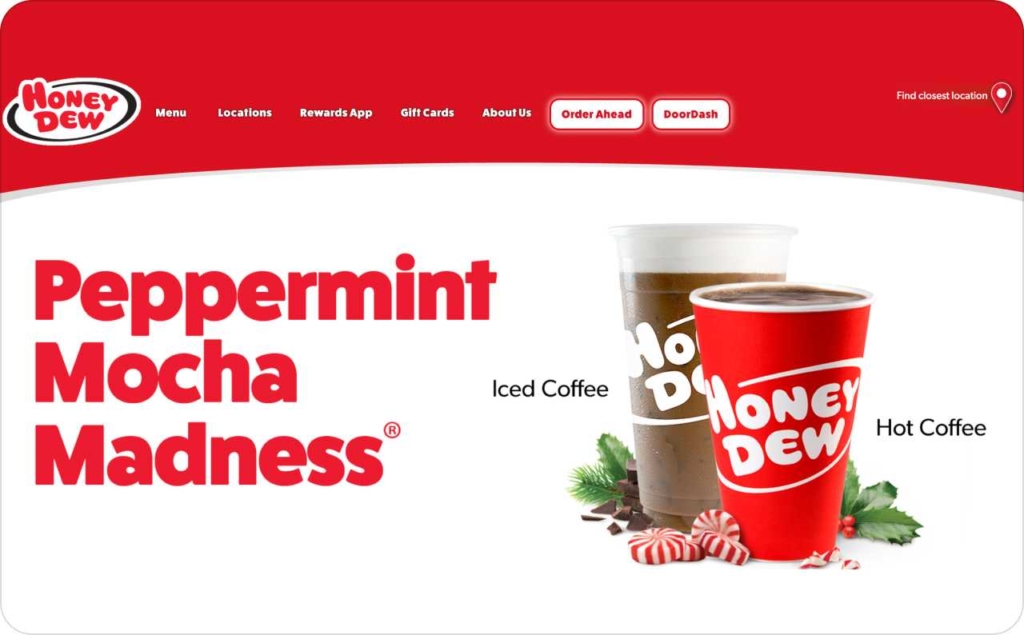
Photo source: Honey New Donuts
First-party & dynamic remarketing
Targeted banner ads tied to product feeds or CRM data consistently outperform broad awareness tactics. When recency, frequency, and creative rotation are well-managed, these ads drive stronger ROAS and incremental conversions. By reconnecting users with products they’ve viewed or added to cart, dynamic remarketing turns intent into measurable return, not wasted impressions.
6. Harry Corry full-funnel home furnishing ad
Harry Corry connected online discovery and in-store sales through targeted banner ads running across display and native placements. By pairing prospecting with dynamic retargeting and automated bidding, the campaign kept engagement high at every stage of the funnel, proving that smart signal use can deliver strong ROAS and efficient CPAs across the UK and Ireland.
Why it works
- Balances upper- and lower-funnel performance within one campaign
- Uses CRM and behavioral data for smarter retargeting
- Connects digital conversions to verified in-store sales
- Optimizes automatically for ROAS, CPA, and view-through lift
How to use it in your advertising: Picture a shopper browsing sofa sets on your website. Later, they see an ad: “Your perfect living room look is waiting in-store.” Use targeted banner ads paired with automated bidding to blend awareness and remarketing. Keep creative consistent across display and native placements, and track both online conversions and in-store validations to capture true performance.
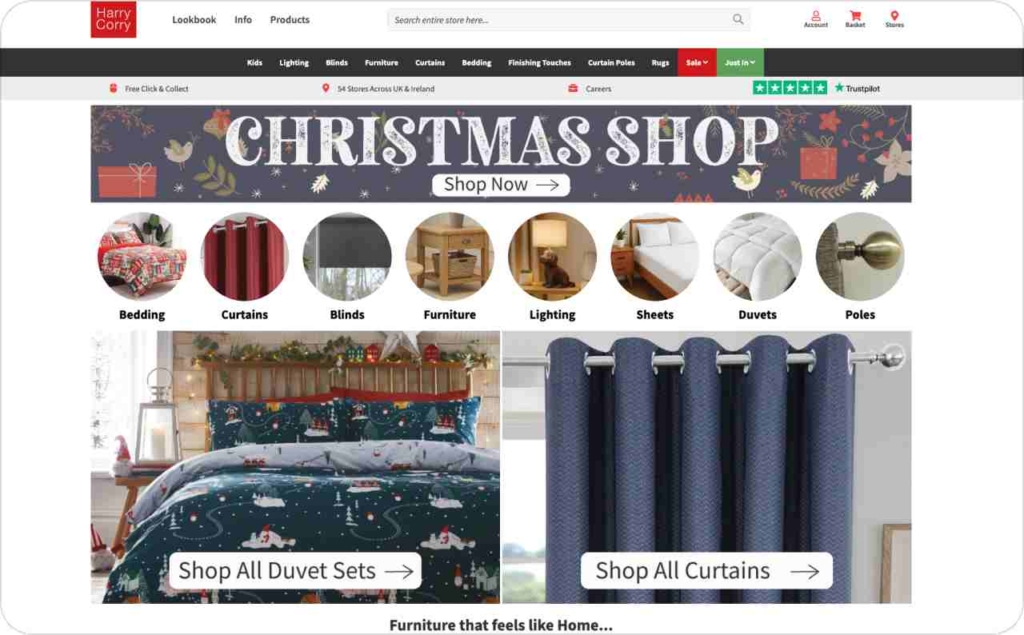
Photo source: Harry Corry
7. Interparfums / Guess Parfums multichannel retail ad
Interparfums used targeted banner ads across multichannel display campaigns to reach fragrance shoppers and re-engage recent site visitors. Combining audience targeting with dynamic retargeting and CPV optimization, Guess Parfums achieved strong store-visit efficiency across EU retail partners, linking ad exposure directly to verified in-store traffic at a low cost per visit.
Why it works
- Blends prospecting and retargeting for full-funnel efficiency
- Uses CPV optimization to prioritize real engagement, not just clicks
- Connects digital impressions to measurable in-store visits
- Maintains consistent brand storytelling across multiple retail networks
How to use it in your advertising: Imagine a shopper browsing new fragrances online, then seeing an ad: “Find your scent in-store today.” Use targeted banner ads with audience and retargeting layers to drive visits where purchase intent is highest. Optimize for cost per visit, and align creative across web and mobile for a targeted mobile advertising to keep the experience seamless.
In-market or modeled audiences
For prospecting, display advertising targeting in-market and modeled cohorts balances reach with efficiency, especially in niche B2B. These campaigns use intent signals, look-alike modeling, and predictive data to identify high-propensity buyers before they engage, helping brands grow new audiences without inflating acquisition costs or sacrificing relevance.

Photo source: Interparfums
8. Westlake Royal Stone Solutions contractor engagement ad
Westlake Royal Stone Solutions used display advertising targeting builders and contractors through mobile placements that combined behavioral and location data. By mapping conversion zones around distributor sites, the campaign segmented audiences based on real-world visitation patterns, turning movement data into clear buyer intent signals and stronger in-market engagement.
Why it works
- Uses behavioral and location data to identify active trade professionals
- Builds high-value audience cohorts from verified offline behavior
- Aligns digital reach with real-world distribution and demand
- Tracks visits by cohort for measurable B2B intent signals
How to use it in your advertising: Picture a contractor visiting a supply yard. Later, they see an ad: “Find premium stone veneers near your next build.” Use display advertising targeting with conversion zones and behavioral filters to reach real buyers, not broad industry lists. Keep creative practical, visual, and tied to job-site needs for authentic resonance.
9. Sika Marine in-market expansion ad
Sika Marine used display advertising targeting in-market audiences across mobile, desktop, and connected TV to reach boat manufacturers and marine repair specialists. By layering geo data onto intent-based segments, the brand expanded visibility beyond its traditional niche and measured regional growth through verified visits and penetration lift.
Why it works
- Combines in-market intent with geo precision to uncover new demand
- Extends brand reach efficiently beyond established trade networks
- Connects multi-device exposure to measurable regional outcomes
- Tracks visits and footprint growth for clear ROI insight
How to use it in your advertising: Picture a marine contractor streaming an industry video. They see an ad: “Trusted adhesives for every vessel, find a distributor near you.” Use display advertising targeting with in-market data and regional geo filters to scale awareness. Keep visuals industry-specific and emphasize reliability and proximity to convert niche attention into active demand.
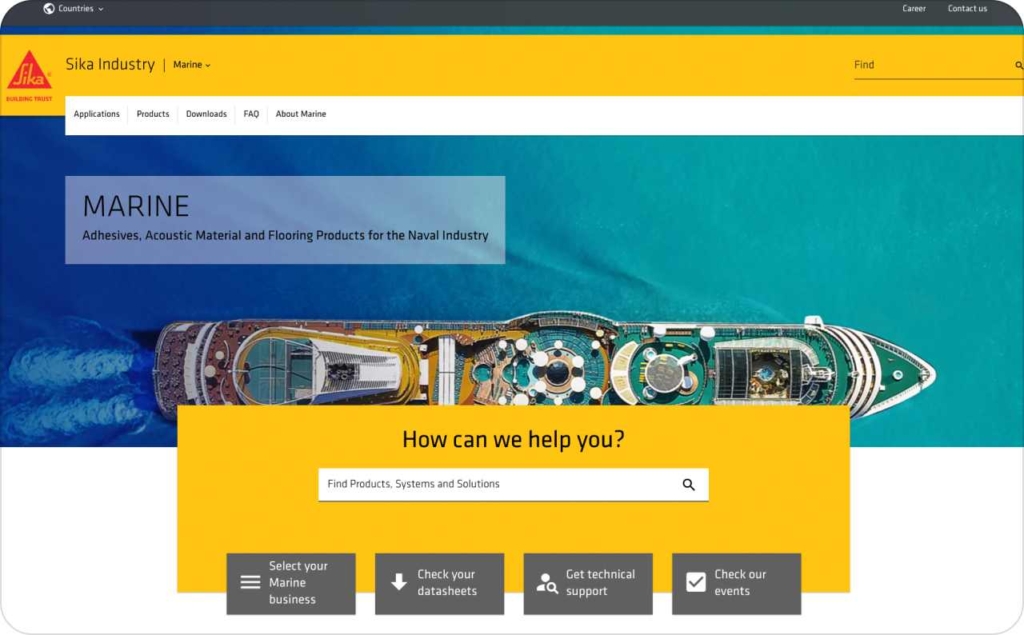
Photo source: Sika Marine
CPG & shopper marketing
Retailer POIs combined with audience overlays make targeted digital display advertising directly accountable to sales lift and distribution growth. By connecting ad exposure to verified purchase or footfall data, brands can measure the real-world impact of digital campaigns, optimizing creative and spend for where in-store conversion truly happens.
10. Gary’s QuickSteak retail sales lift ad
Gary’s QuickSteak used targeted digital display advertising across mobile, connected TV, and audio to drive measurable in-store sales at Walmart and Sam’s Club. By combining location data with retailer POIs, the brand tied ad exposure directly to purchase lift and verified visits, while audio placements extended reach among on-the-go shoppers.
Why it works
- Uses geo and POI data to link ads to real retail outcomes
- Adds audio for incremental reach and stronger recall
- Proves sales impact through verified purchase and visit data
- Optimizes spend for in-store conversions, not just clicks
How to use it in your advertising: Picture a shopper listening to streaming radio near a retailer. They hear, “Dinner’s ready in minutes with Gary’s QuickSteak, find it at Walmart.” Use targeted digital display advertising with retailer POIs and cross-channel placements to reach buyers at the right moment. Keep creative short, appetite-driven, and focused on convenience and availability.
11. Duke Cannon retail lift ad
Duke Cannon used targeted digital display advertising across multichannel placements to connect location-based audiences with nearby mass retailers. By linking ad exposure to verified visits and point-of-sale data, the campaign proved a direct path from digital engagement to in-store sales, turning proximity and intent into measurable retail lift.
Why it works
- Uses location audiences to target shoppers near key retail partners
- Connects verified visits with transactional sales data
- Demonstrates full-funnel visibility from awareness to purchase
- Optimizes for both visit rate and sales lift to show true ROI
How to use it in your advertising: Picture a shopper scrolling grooming tips on their phone. They see an ad: “Find Duke Cannon at Target today.” Use targeted digital display advertising with retailer audience overlays and in-store attribution. Keep messaging confident, straightforward, and product-focused, helpful reminders that meet shoppers where they already buy.
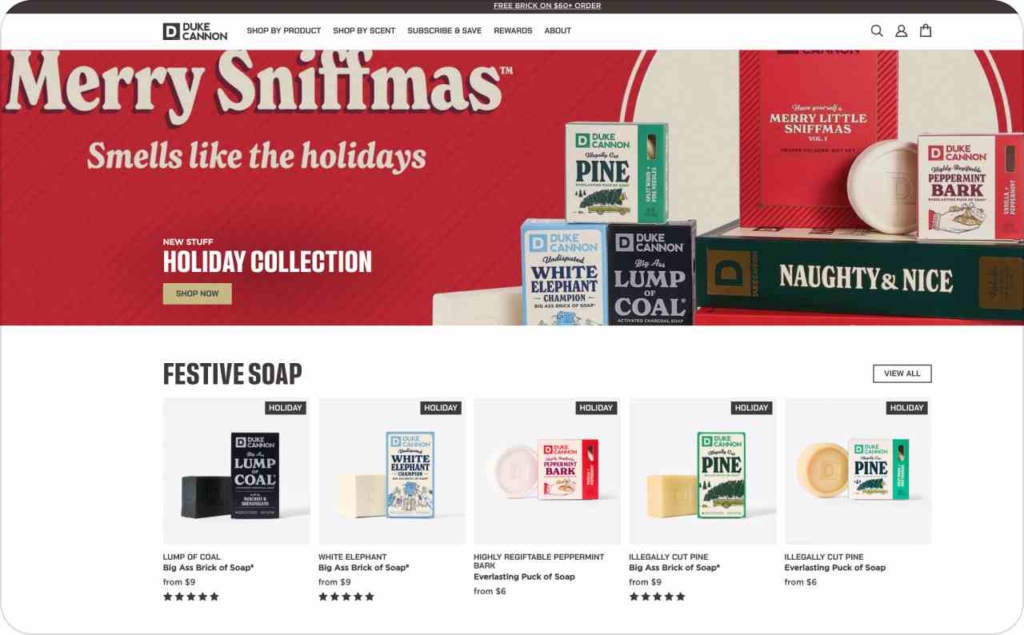
Photo source: Duke Cannon
12. The Sola Company retailer conquesting ad
The Sola Company used targeted digital display advertising on mobile to reach shoppers near competing retailers and drive new traffic to its partner stores. By combining retailer conquesting with POI data, the campaign proved incremental store visits, helping secure expanded shelf placement through verified, data-backed retail performance.
Why it works
- Uses retailer conquesting to attract shoppers from competitor locations
- Links ad exposure to verified new-to-store visits
- Demonstrates measurable retail impact that supports distribution growth
- Keeps spend focused on acquisition, not awareness
How to use it in your advertising: Picture a shopper leaving a competitor’s store and scrolling their phone. They see an ad: “Find a better low-carb option just down the road.” Use targeted digital display advertising with retailer POIs to capture nearby intent. Keep creative simple, benefit-led, and location-specific to turn store traffic into long-term shelf wins.
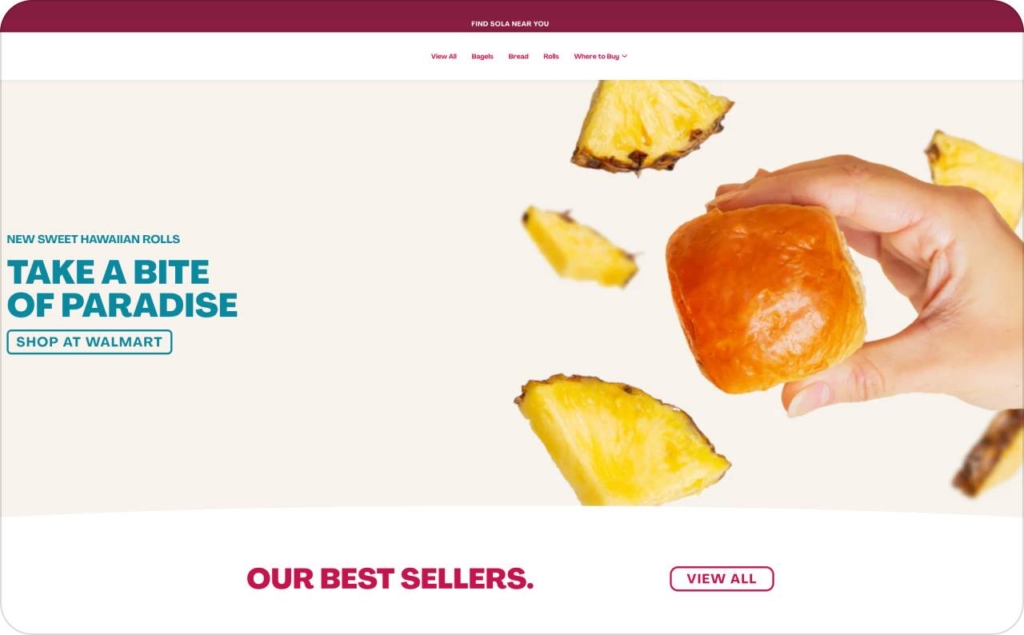
Photo source: The Sola Company
13. Dr. Scholl’s add-to-cart activation ad
Dr. Scholl’s used targeted mobile display advertising to reach shoppers near pharmacies and mass retailers. Through precise location targeting, the brand turned local intent into measurable e-commerce and in-store conversions, boosting add-to-cart rates while driving scale efficiently across mobile audiences.
Why it works
- Uses geo signals to connect product relevance with nearby retail access
- Converts browsing intent into direct add-to-cart actions
- Tracks both online and offline conversion metrics for full-funnel visibility
- Optimizes spend toward high-intent, high-conversion users
How to use it in your advertising: Picture a shopper near a pharmacy scrolling for foot-care advice. They see an ad: “Relief is right around the corner — shop Dr. Scholl’s today.” Use targeted digital display advertising with pharmacy and mass-retail POIs to drive add-to-cart and store visits. Keep creative clean, solution-oriented, and focused on instant availability.

Photo source: Dr. Scholl’s
14. Meguiar’s retail precision ad
Meguiar’s used targeted digital display advertising on mobile to reach auto care shoppers within precise proximity to Walmart locations. By aligning geo data with real-time audience intent, the campaign created a short-flight surge in verified store visits, showing how tight targeting and timing can drive measurable lift at a single retail partner.
Why it works
- Uses precision location data to target shoppers near a specific retailer
- Converts mobile impressions into verified store visits
- Demonstrates immediate lift through short-flight campaigns
- Optimizes for cost per visit (CPV) and localized impact
How to use it in your advertising: Imagine a driver refueling nearby and checking their phone. They see an ad: “Shine starts at Walmart, grab Meguiar’s today.” Use targeted digital display advertising with retailer POIs and proximity filters to prompt quick, local action. Keep copy direct and time-sensitive to maximize short-term visit spikes.
15. Giltuss retail visit lift ad
Giltuss used targeted digital display advertising across mobile and digital out-of-home (DOOH) channels to reach shoppers near key pharmacy and retail partners. By layering retailer targeting with verified footfall data, the brand demonstrated measurable visit lift as a proof that supported new distribution wins and expanded retail visibility for its OTC cough and cold products.
Why it works
- Combines mobile and DOOH reach for stronger local presence
- Uses retailer targeting to drive verified store traffic
- Connects visit lift directly to distribution gains
- Builds retailer confidence through transparent performance data
How to use it in your advertising: Picture a commuter passing a pharmacy and seeing a digital screen ad: “Relief is closer than you think, find Giltuss inside.” Reinforce that message with targeted digital display advertising on mobile within the same radius. Keep creative clear, benefit-focused, and action-driven to move shoppers from awareness to purchase in a single trip.
Retail & specialty
For launches and seasonal pushes, target banner ads can pace to a store-visit goal while staying brand-safe. By tying creative timing and audience reach to openings, events, or seasonal windows, brands use performance-driven display to create awareness that converts, proving that smart pacing and local relevance outperform broad reach every time.
16. Ulta Beauty new-store rollout ad
Ulta Beauty used target banner ads on mobile to build awareness and drive visits around new store openings. By targeting audiences within fresh geo catchments, the campaign accelerated visitation rates, helping new locations reach average weekly footfall faster than baseline benchmarks while maintaining brand safety and precision.
Why it works
- Uses geo rollouts to build audience familiarity before and after opening
- Measures “time to threshold” visits for performance clarity
- Keeps creative aligned with new-store excitement and local relevance
- Delivers efficient awareness-to-visit conversion without broad overspend
How to use it in your advertising: Picture a shopper near a new retail center seeing an ad: “We’ve just opened near you, come see what’s new.” Use target banner ads with new-store geo rollouts to ramp visitation quickly. Keep messaging upbeat, specific to location, and focused on discovery rather than discount.
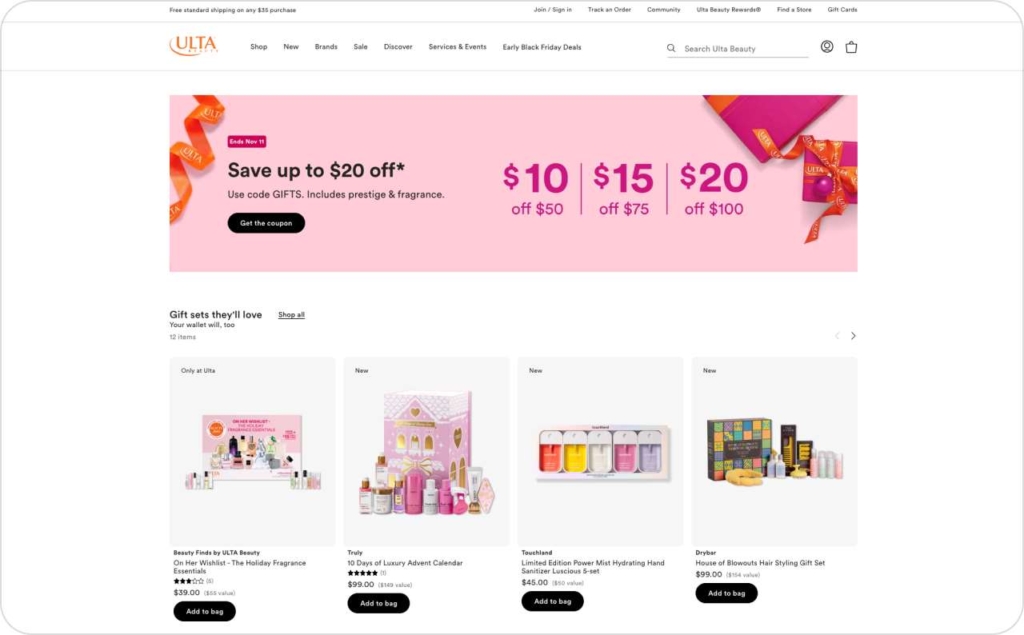
Photo source: Ultra Beauty
17. Coach holiday visit-pacing ad
Coach used target banner ads with cost-per-visit (CPV) display buying to guarantee store traffic during the holiday season. The campaign prioritized outcome-based delivery, pacing impressions toward verified in-store visits rather than standard reach, ensuring that every ad dollar drove measurable, high-quality retail footfall.
Why it works
- Shifts buying model from impressions to verified outcomes
- Uses CPV display to guarantee store-visit performance
- Maintains visit pacing and quality throughout seasonal surges
- Proves real ROI through tracked in-store engagement
How to use it in your advertising: Picture a shopper browsing gift ideas online. They see an ad: “Find timeless gifts waiting in-store today.” Use target banner ads with CPV optimization to focus delivery on real visits, not views. Keep visuals premium, festive, and time-sensitive to convert browsing intent into store traffic.
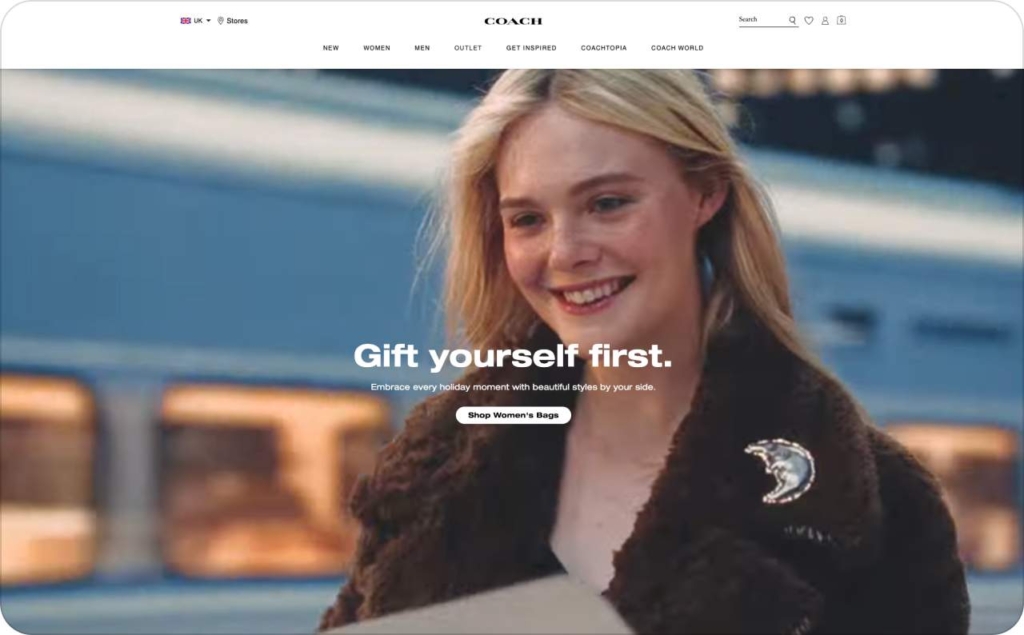
Photo source: Coach
18. Comporium loyalty cohort ad
Comporium used target banner ads on mobile to reach existing loyalty members and nearby shoppers, driving repeat visits across its regional telecom and grocery locations. By targeting loyalty cohorts with personalized creative and timing, the brand achieved higher repeat-visit rates and strong ROAS, proving that relevant reminders outperform broad remarketing.
Why it works
- Targets loyalty segments to strengthen customer retention
- Uses timing and location to prompt repeat store visits
- Optimizes for ROAS and repeat-visit efficiency
- Reinforces brand familiarity without overspending on new acquisition
How to use it in your advertising: Picture a loyalty member who recently shopped in-store. They see an ad: “Your rewards are waiting — visit again this week.” Use target banner ads tied to loyalty or CRM data to boost repeat shopping. Keep creative timely, rewarding, and focused on convenience or exclusive offers.

Photo source: Comporium
Food & hospitality
Pairing contextual signals like menus, maps, and events with proximity turns targeted display into a driver of real-world results. Restaurants, venues, and local experiences can use location and timing to reach guests when intent peaks, transforming digital attention into booked tables, sold tickets, and measurable on-site revenue.
19. Dave’s Hot Chicken sales lift ad
Dave’s Hot Chicken used targeted display across mobile and connected TV to reach nearby diners and track real sales impact. By layering audience segments with precise location data, the brand achieved higher ROAS and measurable sales lift, proving that well-timed creative can turn appetite into conversion at scale.
Why it works
- Combines geo precision with audience intent to drive real revenue
- Connects digital impressions to verified sales outcomes
- Uses cross-channel reach for stronger brand recall
- Measures ROAS and sales lift to validate campaign efficiency
How to use it in your advertising: Picture someone streaming a food review at lunchtime. They see an ad: “Craving heat? Dave’s Hot Chicken is just minutes away.” Use targeted display across mobile and CTV to reach hungry audiences nearby. Keep creative sensory and time-specific — short, bold, and built for immediate action.
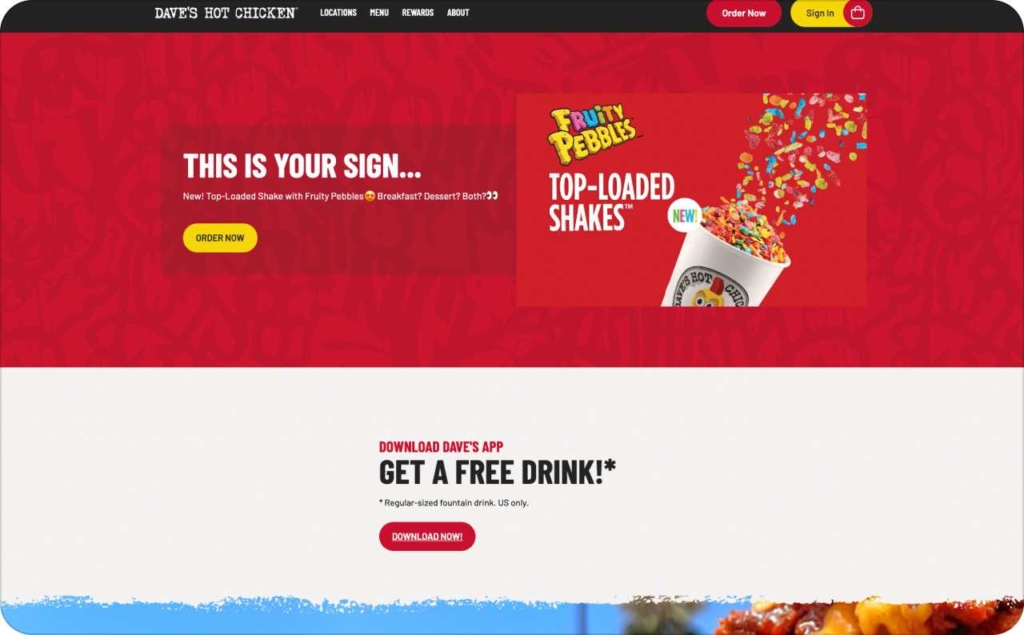
Photo source: Dave’s Hot Chicken
20. Florida Keys Tourism destination engagement ad
Florida Keys Tourism used targeted display campaigns that paired contextual travel content with geo-based audience targeting to reach potential visitors at the moment of inspiration. By aligning creative with travel intent, articles, maps, and booking research, the campaign drove higher engagement rates and measurable downstream visits to the region.
Why it works
- Combines contextual relevance with geo targeting for precise reach
- Engages audiences already in the research or planning phase
- Builds destination awareness through high-quality impressions
- Tracks engagement rate and downstream visits for clear performance insight
How to use it in your advertising: Imagine a traveler reading a “best winter getaways” article. They see an ad: “Find your next escape in the Florida Keys.” Use targeted display to reach users in travel-planning contexts, aligning creative with exploration and relaxation. Keep visuals immersive and copy aspirational but clear, guiding inspiration toward measurable visitation.
Reasons to use an AI ad generator for your targeted display ads
Running display campaigns used to mean long production times, high costs, and too much guesswork. With Zeely, an AI-powered ad tool for SMBs, marketers, and e-commerce, you can create high-performing visuals and messages in minutes. As a business growth app, Zeely automates ad creation, sharpens targeting, and helps you get measurable results without big budgets or complex setups.
Common pain points and how Zeely solves them
- No time to design or test ads → Zeely’s AI generator for ads builds ready-to-launch creatives in minutes, cutting ad setup time dramatically
- Low budget ads with weak results → Smart optimization boosts ROAS so even small budgets work harder
- No design skills → Paste your product link, Zeely generates professional visuals, headlines, and CTAs automatically
- Campaign complexity → One dashboard handles creation, targeting, and analytics for faster decisions
- Low conversion rates → AI matches message and placement to user intent, driving better engagement
- Scaling problems → Instantly create and test multiple versions, then scale what performs best
- Wasted ad spend → Zeely’s optimization focuses delivery on high-intent audiences to reduce waste and boost efficiency
Why it works
Zeely removes the barriers that slow teams down. It’s simple, affordable, and built to make targeted display ads effortless — from creation to performance tracking.
Start today: Try Zeely’s AI ad generator to create your first campaign in minutes. No design skills needed, no big budget required, just fast, data-driven ads that help your business grow.
Also recommended

